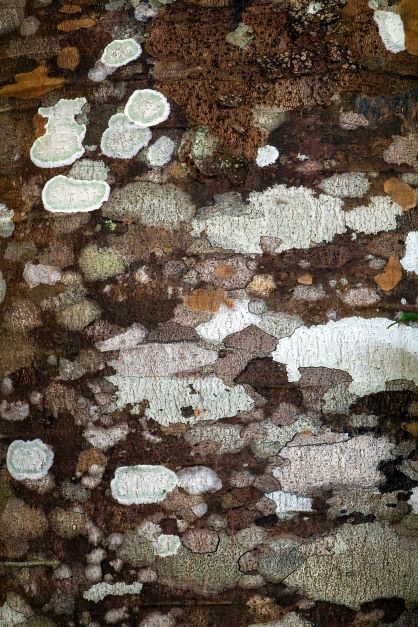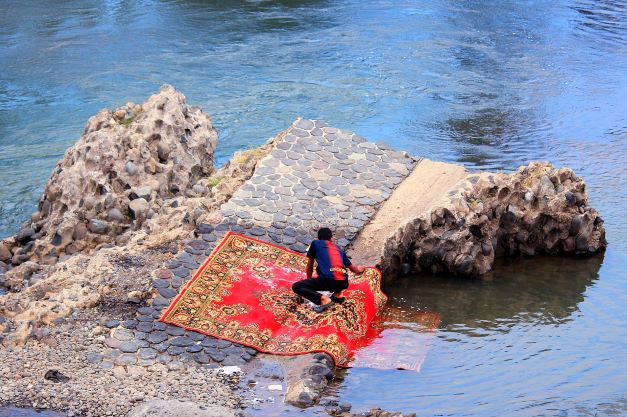Yes. An outdoor rug is a kind of rug that can withstand the elements, such as wind, sun, and rain, without showing signs of wear and tear. The backing and chemicals used in the manufacturing process of the fabric both contribute to the durability of outdoor carpets over time.
Outdoor rugs are a popular and effective choice for freshening up areas of your property that are accessible from the outside.
Can outdoor rugs be left in the rain?
Yes. Outdoor rugs can be left in rain. When shopping for an outdoor rug, it’s critical to consider the rug’s construction material. The best outdoor rugs are made of synthetic fibers, which are resistant to stains, mildew, and fading since they are built to withstand all weather conditions. If you want an outdoor rug that can be kept outside in the rain, synthetic fabrics are your best option. Engineered materials including polypropylene, nylon, olefin, and polyester are utilized to manufacture the strongest outdoor carpets.
When exposed to dampness, all-fiber carpets may develop mildew. With time, mildew will eat away at the fibers of the carpets, causing them to fall apart.
No matter what sort of carpeting you choose to install, you should always acquire a pad to place below it. It is a wonderful accessory that, when added to your rug, will make it more functional in a variety of ways.
The increased airflow that is created underneath a rug as a result of the use of a rug pad is one of the most significant advantages of using a rug pad. It is impossible for air to circulate beneath the carpets since there isn’t a cushion there. There is the potential for a variety of issues to result from circulation that is either inadequate or nonexistent. When ventilation is inadequate, there is a greater risk of the growth of mold, mildew, and germs. A rug pad is a simple and inexpensive option that may improve blood flow and help prevent difficulties like these.
Another potential problem is that particles of dirt and other debris could get caught in the space between the rug and the deck or patio that lies underneath it. The rug pad acts as a barrier between the rug and the floor. When this happens, the dirt and debris in issue will no longer be able to discolor or stain the wood or the concrete.
Rug pads may also be used to lessen the risk of falls. This is especially a problem on smoother flooring, where the rug may more readily slide about. Putting a rug cushion below it will prevent it from moving around. This is helpful so the rug doesn’t have to be moved around so much. If you put a decent rug pad under it, it won’t shift.
Also Read. best area rugs for pets
Do outdoor rugs need to be covered?
No. outdoor rugs do not need to be covered or have a covering built over them. The term “outdoor rug” refers to rugs or carpets that are constructed from materials that are resistant to the effects of weather and are designed to be used in environments that are exposed to natural elements. Despite this, the fabric of these materials, which is used in the building of these things, will ultimately wear out since it is constantly exposed to the elements, such as rain, wind, and sunshine. As a consequence of this, the longevity of such carpets decreases with the passage of time. Protecting your outdoor rug from the weather and extending its usable life may be accomplished by covering it.
Will outdoor rug get moldy?
Yes they do get moldy. Even if they are made of synthetic materials that are resistant to mold growth, outdoor carpets still run the risk of becoming moldy. Mold cannot grow on the synthetic strands that are used to construct these carpets; but, an accumulation of dirt, grass clippings, food scraps, and moisture will favor mold growth. In order to prevent mold formation, you should clean your outside environment on a regular basis. In order to properly clean the rug, any dirt or moisture that may have accumulated on it as a result of its exposure to the outdoors must be removed (such as rain or snow). Spraying rugs with a mold-resistant sprayer on a periodic basis is recommended.
Can you leave an outdoor rug out all summer?
Yes you can. If you want to put a rug in your yard, you should look for one that is made exclusively for use outside and not inside the house. On the other hand, they will sustain significant harm if they are not shielded from the elements during the whole year. If you plan on leaving your outdoor rug exposed to the sun for the whole of the summer without preserving it in any way, you should be aware that it is likely to suffer from some degree of fading.

How do you protect an outdoor rug from the sun?
Place carpets and rugs out of direct sunlight. This is the best method for protecting carpets and rugs from the damaging effects of the sun, which will stop them from becoming faded. A natural and unavoidable process, fading is brought on by a multitude of factors, including location, the amount of time an object is exposed to light, the strength of the color, as well as the types of dyes and methods of dying that were used. Fading occurs over time and cannot be stopped.
Even if you don’t see any change right away, the carpet or rug will begin to fade as soon as it is exposed to natural light for the first time. If you want to maintain the pristine state of your carpet or rug for as long as possible, the ideal time to take action is right away.
If you want to avoid sun washing on your rug, you could think about putting it in the shade or beneath a patio umbrella. You may also install a sunshade or cover over the area of your patio where your outdoor rug is located if you don’t want to use an umbrella.
How to restore the original color of your carpets and rugs.
There are several approaches you may take to restore the original color of your carpets and rugs. A solution of hot water and salt is one method that is both easy and risk-free to use. To begin, put an equal amount of salt into boiling water and whisk the mixture until the salt is dissolved. After that, give the carpet or rug a thorough vacuuming, and then apply the mixture using a dampened cloth. After the carpet or rug has had time to dry, you should vacuum it one more to remove the salt.
Do polypropylene rugs get hot in the sun?
Yes. It is susceptible to damage from heat as well as friction. Although it has a melting point of around 300 degrees Fahrenheit, it may still be damaged at temperatures lower than that.

When exposed to direct sunshine, rugs made of polypropylene degrade in quality.
Even while no rug can really survive the weather, rugs constructed with polypropylene yarns that have been UV-treated will last far longer when placed outside.
Polypropylene carpets are not only resistant to fading and stains, but they can also survive a significant amount of wear and tear from regular usage in addition to the natural elements.
Can I leave my outdoor rug outside all winter?
Yes, you can put outdoor rugs outside in winter. Outdoor carpets are designed to withstand the sun, rain, sleet, and snow throughout the whole year. The winter weather is affected by location. A rug meant for outdoor use must be able to endure snow as well as rain. Cold, icy, snowy, slushy. In most cases, polypropylene or other types of synthetic fibers are used in their construction. They are impervious to water and do not hold any moisture in their structure.

If you do not reside in an area where winters are mild and dry, bringing your rug indoors will almost certainly lengthen its lifespan. Because of the chilly weather, outdoor areas in the UK, for example are often wet and muddy.
How long do outdoor rugs last?
In most cases, they endure between three and five years, but in exceptional cases, they may even go on for 10. Unfortunately, despite their longevity, outdoor carpets begin to show symptoms of wear and tear after just a few years of use. This is one of the drawbacks of their durability. For instance, some people rotate their rugs periodically in order to give them a break from the heat of the sun. When viewed from any angle, I feel that by the fourth year, it will be impossible to escape the need of purchasing a new rug.
How do you keep outdoor rugs from getting moldy?
Here are several ways to keep outdoor rugs from getting moldy. Carpets may be cleaned by sweeping, vacuuming, or shaking to remove dirt and debris. After applying a mixture of bleach and water to the rug on your driveway, be sure to properly rinse it afterwards. You should let it air dry in the sunlight.
Method with baking soda and vinegar: If the rug cannot be cleaned with bleach, you may try using baking soda and vinegar instead. After the area has been cleaned of the dirt and other debris, baking soda should be sprinkled over it. Spray the affected region with vinegar that has been partially filled into a spray bottle. Give it a few minutes to take in the liquid. It is common for you to observe it bubbling, so don’t be alarmed. After that, wash it well and then let it dry in the sunlight.
It is recommended that you make use of a pressure washer in order to ensure that your rug is well cleaned.
A rug that has been soaked may be dried by wrapping it up tightly and then squeezing out any extra water that has accumulated.
Before using any cleaning method on your rug, including baking soda and vinegar, you should always do a spot test on a tiny area first.

Why does my outdoor rug get moldy?
Outdoor rugs get moldy when they are exposed to frequent rain or moisture. No matter how good the outdoor rug is in resisting mold, it will eventually get moldy due to moisture trapped in the fibers of the rug if exposed to frequent rain or moisture. Your outdoor rug can also be ruined by mildew
Does mold grow under outdoor rugs?
Yes. Mold does grow under outdoor rugs. Even though the vast majority of outdoor carpets are resistant to mold and mildew, these troublesome fungi may still develop on them if they are allowed to accumulate dirt and moisture.
Even though they were made specifically to withstand the elements of the great outdoors, outdoor carpets are nonetheless susceptible to the whims of mother nature. In addition to the stains that may be produced by leaves and dirt, the moisture that may be present as a result of precipitation like as rain or snow may also foster the formation of mildew and mold deep inside the fabric. If you maintain your outdoor rug on a regular basis, it will make it look like new for a longer period of time, and it will also help keep the area around it clear of dirt and other debris.
Do outdoor rugs get moldy in the rain?

Yes. Mold will start to spread beneath an outdoor rug if it is exposed to the elements for a long period of time, such as when it is left out in the rain. Mold will begin to develop the moment water comes into touch with other organic matter, such as dust, leaves, discarded food, etc. Even while a high-quality outdoor rug may keep the rain away, it will not prevent the formation of mold if dirt is allowed to accumulate in settings where there is excess moisture. Your best protection against mold growth in an outdoor rug is to examine it often and give it a thorough washing on a regular basis. During the rainy season, you should give your outdoor carpeting a thorough cleaning and make sure it is completely dry after each session.
Can you leave outdoor rug on deck?

The usage of any rug, regardless of whether it is natural or synthetic, has the potential to harm the surface of a deck that has been stained. When it rains, there is no way around the fact that the rug will be wet for at least a little while. Because of this, the covered portion of the deck would retain its moisture for a greater amount of time compared to the unprotected portions of the deck, which would eventually contribute to the growth of mildew. A rug made of natural fibers will be able to absorb water, however a rug made of synthetic fibers like polyester would not, which may make the mildew problem much worse.
How do you take care of outdoor rugs?
1. First, using a strong broom, shake the rug to remove any loose debris, dirt, or grass that may be present. Next, vacuum the rug well to remove any remaining particles. After that, you should thoroughly vacuum the area.
2. Next, remove any remaining pollutants and dirt that are loose by using a water hose. Pay a bit extra attention to the spots that have mold and mildew. The water pressure from a regular garden hose is sufficient to wash away the vast majority of dirt.
3. After you have finished cleaning the whole rug, apply a solution made of dish soap and water to the problem spots, and then scrub vigorously with a brush that has a firm bristle.
4. Carry out a careful and complete cleaning. If you want the rug to continue to have a great appearance for a number of months, it is imperative that you remove all of the soap from the rug.
5. After you have finished cleaning the rug, you should hang it out in the fresh air so that excess water may drain off and it can complete drying.

It is also essential to keep in mind that the kind of washing described here is only suitable for synthetic luke pile rugs that have been manufactured expressly for usage outside. Do not attempt to clean any hand-knotted wool carpets in this manner. If you have any queries about the care of your rug investment, you should visit a rug specialist in your area.
Can I put an outdoor rug on concrete?
If the concrete flooring in your outdoor space aren’t sealed, some types of outdoor rugs could have difficulties sticking to them. Since mildew may form on surfaces that are not permeable, it is advisable to pick a rug that enables moisture to drain since this will prevent the growth of mildew.
Can I put an outdoor rug on grass?
Yes, outdoor rug can be put on grass. You should be aware, however, that laying a rug on top of a grassy area will have the effect of retaining any moisture that may be present in the grass. Even if the rug is permeable to air, the fact that it has been in close proximity to damp ground for an extended period of time can cause mold and mildew to slowly grow on its backing, which will eventually compromise the rug’s structural integrity.

Click-lock tiles made of wood-plastic composite or plastic may also serve as an alternative for temporary flooring. In the event that the rug becomes wet, this might serve as an underlayment and help it dry more quickly. You also have the option of hanging the rug outdoors on occasion and allowing it to dry in the sun until it is totally done.